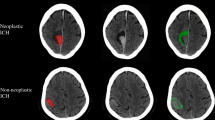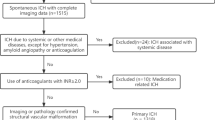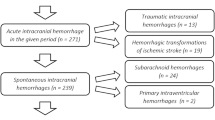Abstract
Background
The clinical impact of routine neuropathologic examination of samples from patients with intracerebral hemorrhage (ICH) is unclear.
Methods
Therefore, we evaluated a consecutive series of 378 surgical specimens from patients with ICH concerning demographic data, localization of hemorrhage, preoperative clinical diagnosis and neuropathological diagnosis.
Results
Histological examination revealed the putative origin of ICH in 143 cases (37.8%). Vascular pathologies were detected in 127 patients (33.6%), while tumors were identified in 9 patients (2.4%), infarction in 6 patients (1.6%) and abscess in 1 patient (0.3%). Preoperatively, tumor was considered in 65 patients (17.2%), while vascular malformations were supposed in 94 patients (24.9%), infarction in 18 cases (4.8%) and abscess in 3 cases (0.8%). In 198 patients (52.4%) no specific assumption was made.
Conclusions
Comparing preoperative assumptions and histological diagnoses, tumor, vascular malformations and infarctions were clinically overestimated, while arteriolosclerosis and amyloid angiopathy were underestimated. In conclusion, we found that histological findings potentially affecting clinical management and prognosis were obtained in 37.8% of cases. Our data suggest that histopathological examination of intracerebral hemorrhage provides important information for patient management and should be routinely performed.


Similar content being viewed by others
References
Neuropathology Group of the Medical Research Council Cognitive Function and Ageing Study (MRC CFAS) (2001) Pathological correlates of late-onset dementia in a multicentre, community-based population in England and Wales. Lancet 357:169–175
Abrahams NA, Prayson RA (2000) The role of histopathologic examination of intracranial blood clots removed for hemorrhage of unknown etiology: a clinical pathologic analysis of 31 cases. Ann Diagn Pathol 4:361–366
Brewer DB, Fawcett FJ, Horsfield GI (1968) A necropsy series of non-traumatic cerebral haemorrhages and softenings, with particular reference to heart weight. J Pathol Bacteriol 96:311–320
Elhammady MS, Baskaya MK, Heros RC (2008) Early elective surgical exploration of spontaneous intracerebral hematomas of unknown origin. J Neurosurg 109:1005–1011
Greenberg SM, Eng JA, Ning M, Smith EE, Rosand J (2004) Hemorrhage burden predicts recurrent intracerebral hemorrhage after lobar hemorrhage. Stroke 35:1415–1420
Greenberg SM, Gurol ME, Rosand J, Smith EE (2004) Amyloid angiopathy-related vascular cognitive impairment. Stroke 35:2616–2619
Hazrati LN, Bergeron C, Butany J (2009) Neuropathology of cerebrovascular diseases. Semin Diagn Pathol 26:103–115
Hearp ML, Locante AM, Ben-Rubin M, Dietrich R, David O (2007) Validity of sampling error as a cause of noncorrelation. Cancer 111:275–279
Heineman HS, Braude AI, Osterholm JL (1971) Intracranial suppurative disease. Early presumptive diagnosis and successful treatment without surgery. JAMA 218:1542–1547
Jellinger K (1977) Pathology of intracerebral hemorrhage. Zentralbl Neurochir 38:29–42
Jellinger KA, Lauda F, Attems J (2007) Sporadic cerebral amyloid angiopathy is not a frequent cause of spontaneous brain hemorrhage. Eur J Neurol 14:923–928
Kalkanis SN, Kondziolka D, Gaspar LE, Burri SH, Asher AL, Cobbs CS, Ammirati M, Robinson PD, Andrews DW, Loeffler JS, McDermott M, Mehta MP, Mikkelsen T, Olson JJ, Paleologos NA, Patchell RA, Ryken TC, Linskey ME (2009) The role of surgical resection in the management of newly diagnosed brain metastases: a systematic review and evidence-based clinical practice guideline. J Neurooncol 96:33–43
Khasraw M, Lassman AB (2010) Advances in the treatment of malignant gliomas. Curr Oncol Rep 12:26–33
Kothbauer P, Jellinger K, Falment H (1979) Primary brain tumour presenting as spontaneous intracerebral haemorrhage. Acta Neurochir (Wien) 49:35–45
McCormick WF, Rosenfield DB (1973) Massive brain hemorrhage: a review of 144 cases and an examination of their causes. Stroke 4:946–954
Mutlu N, Berry RG, Alpers BJ (1963) Massive Cerebral Hemorrhage Clinical and Pathological Correlations. Arch Neurol 8:644–661
Niedermayer I, Romeike BF, Feiden W (1999) Spontaneous intracerebral hemorrhages. Neuropathologic aspects. Radiologe 39:821–827
Pfeifer LA, White LR, Ross GW, Petrovitch H, Launer LJ (2002) Cerebral amyloid angiopathy and cognitive function: the HAAS autopsy study. Neurology 58:1629–1634
Richter H (2003) Recommendations for the neuropathologic examination of tissue samples. Mitt Dtsch Ges Neurochirur. 13
Ross J, Al-Shahi Salman R (2010) Interventions for treating brain arteriovenous malformations in adults. Cochrane Database of Systematic Reviews 2010, Issue 7. Art. No.:CD003436:10.1002/14651858.CD003436.pub3
Simmons DM, Swanson LW (2009) Comparing histological data from different brains: sources of error and strategies for minimizing them. Brain Res Rev 60:349–367
Smith EE, Gurol ME, Eng JA, Engel CR, Nguyen TN, Rosand J, Greenberg SM (2004) White matter lesions, cognition, and recurrent hemorrhage in lobar intracerebral hemorrhage. Neurology 63:1606–1612
Stummer W, Kamp MA (2009) The importance of surgical resection in malignant glioma. Curr Opin Neurol 22:645–649
Zulch KJ (1968) Neuropathology of intracranial haemorrhage. Prog Brain Res 30:151–165
Conflicts of interest
None.
Author information
Authors and Affiliations
Corresponding author
Rights and permissions
About this article
Cite this article
Holling, M., Jeibmann, A., Fischer, B.R. et al. Histopathological analysis of intracerebral hemorrhage: implications for clinical management. Acta Neurochir 154, 439–443 (2012). https://doi.org/10.1007/s00701-011-1260-6
Received:
Accepted:
Published:
Issue Date:
DOI: https://doi.org/10.1007/s00701-011-1260-6




